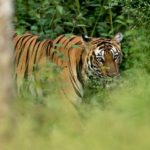Complete List of National Parks & Wildlife Sanctuaries of Jammu and Kashmir
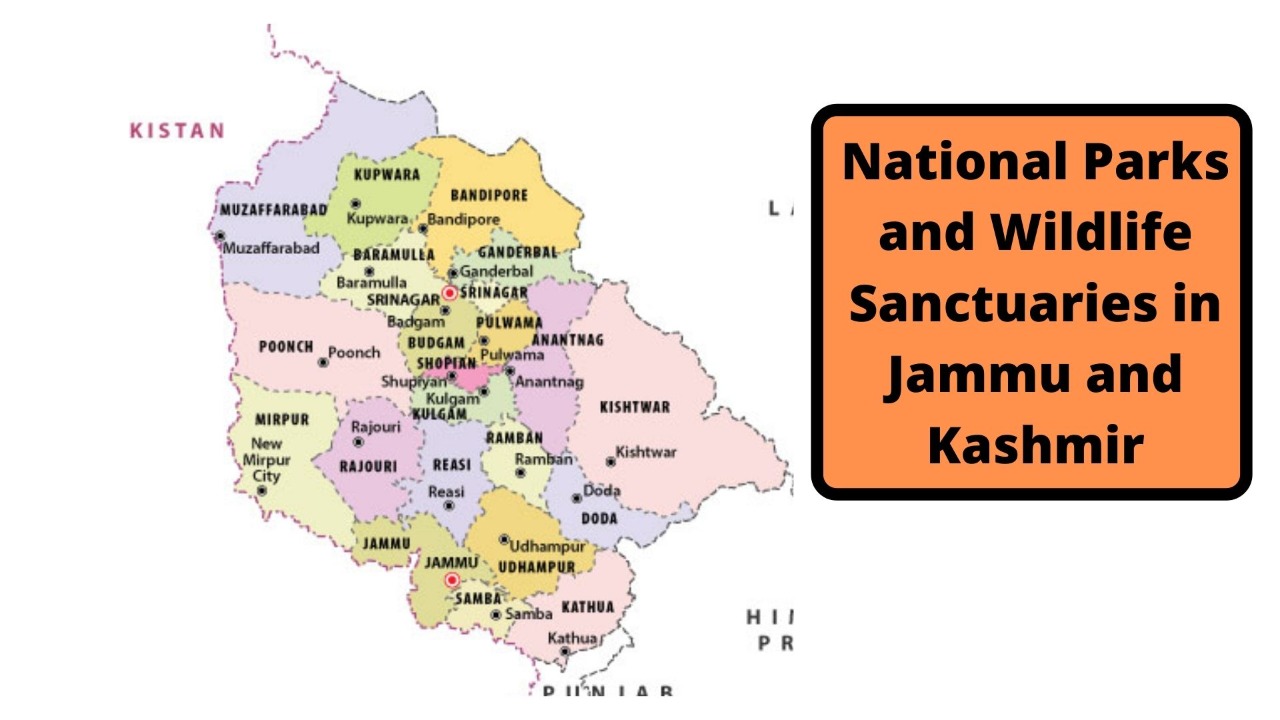
Resembling a crown to the nation on the map, Jammu & Kashmir was accorded as union territory by article 370 of the Indian Constitution. J&K was a place to explore since ages, making it one of the top tourist destinations. It is home to the Kashmir Valley, Chenab Valley, Sindh Valley and Lidder Valley. Besides scenic beauty, there are flower gardens, apple farms and many more attractive locations. Major tourist attractions in Jammu and Kashmir include Srinagar, Mughal Gardens, Patnitop, Pahalgam, Gulmarg, and Jammu. Thousands of pilgrims visit holy shrines of Vaishno Devi and Amarnath every year and this has a significant impact on the state’s economy.
State Animal of Jammu & Kashmir is: The Kashmir Stag (aka Hangul)
The Kashmir stag (Cervus canadensis hanglu), also called hangul, is a subspecies of elk native to India. It is found in dense riverine forests in the high valleys and mountains of the Kashmir Valley and northern Chamba district in Himachal Pradesh. In Kashmir, it’s found in the Dachigam National Park where it receives protection but elsewhere it is more at risk. In the 1940s, the population was between 3000 and 5000 individuals, but since then habitat destruction, over-grazing by domestic livestock and poaching have greatly reduced that dramatically. Earlier believed to be a subspecies of red deer (Cervus elaphus), a number of mitochondrial DNA genetic studies have revealed that the hangul is part of the Asian clade of the elk (Cervus canadensis) and has not been evaluated by the IUCN
This deer has a light rump patch without including the tail. Its coat color is brown with a speckling to the hairs. The inner sides of the buttocks are greyish white, followed by a line on the inner sides of the thighs and black on the upper side of the tail. Each antler consists of five tines. The beam is strongly curved inward, while the brow and bez tines are usually close together and above the burr.
National Parks and Wildlife sanctuaries of Jammu and Kashmir
Besides the scenic beauty and high-altitude mountains, the state has a finite list of popular national parks and wildlife sanctuaries. Here is the list of the wildlife reserves in Jammu and Kashmir-
- Thajwas (Thajiwas) (Baltal) Wildlife Sanctuary
- Changthang Cold Desert Wildlife Sanctuary
- Gulmarg Wildlife Sanctuary
- Hirpora (Heerpora) Wildlife Sanctuary
- Hokersar Wildlife Sanctuary
- Jasrota Wildlife Sanctuar
- Karakoram (Nubra Shyok) Wildlife Sanctuary
- Lachipora Wildlife Sanctuary
- Limber (Kazinag) Wildlife Sanctuary
- Nandini Wildlife Sanctuary
- Overa Aru Wildlife Sanctuary
- Rajparian (Daksum) Wildlife Sanctuary
- Ramnagar Rakh Wildlife Sanctuary
- Surinsar Mansar Wildlife Sanctuary
- Trikuta Wildlife Sanctuary
- Hemis Altitude National Park
- Dachigam National Park
- Kishtwar High Altitude National Park
Baltal Wildlife Sanctuary:
Baltal Wildlife Sanctuary, also known as Thajwas Wildlife Sanctuary and Thajiwas Wildlife Sanctuary was established in 1987. There are 11 mountains within the wildlife reserve. This is one of the important place of halt for Amarnath trekking. Many bird species and mammals are seen here.
Gulmarg Wildlife Sanctuary:
Situated in Baramulla district of Jammu and Kashmir, Gulmarg Wildlife Sanctuary spreads over 180 square kilometers. The sanctuary lies in the Pir Panjal Range of the Western Himalayas and the famous golf course, Gulmarg Golf Club is a part of it.
The vegetation of the Gulmarg Wildlife Sanctuary mainly consists of sub-alpine forests with silver fir restricted to moist aspects and Pinus griffithii, Taxus wallichiana and Picea smithiana at lower altitudes. Common wildlife spotted here are Himalayan brown bear, Asiatic black bear, Leopard, Musk deer, Kashmir grey langur, Snow leopard, Tibetan wolf, Red fox, Leopard cat, Jungle cat and Yellow-throated marten.
Hirpora Wildlife Sanctuary:
Hirpora Wildlife Sanctuary or Heerpora Wildlife Sanctuary spreads over an area of 341 square kilometers and is in the Shopian district of Jammu and Kashmir. The slopes are gentle to moderately steep on the eastern part. Further, they are very steep with many cliffs on the higher northern and western aspect. The southern and southeastern parts are moderately steep.
The flora part here are mixed coniferous forests, deciduous sub-alpine scrub forests and sub-alpine pastures. The coniferous forest is dominated by Kail pine with spruce and fir. It is rockier and more open northwestern portion is predominantly sub-alpine scrub forest dominated by juniper and the Kail pine as an associated species.
The highlight of fauna here are around 50 individuals, the critically endangered Pir Panjal markhor. Hirpora is home to Himalayan black bear, Himalayan brown bear, leopard, musk deer, Tibetan wolf, and Himalayan palm civet.
Hokersar Wildlife Sanctuary :
Hokersar Wildlife Sanctuary is popularly known for wetlands and breeding place for migratory birds of Jammu Kashmir. It is located 10 km from the capital city, Srinagar. The wetland here is the largest bird reserve in the Kashmir Valley.
The wetland consists of three zones with varied flora. The northeastern zone with various dense macrophytes, Trapa natans and Phragmites australis are found predominantly in the central zone, which is a large water basin. The southern zone is a silted portion and acts as a pastureland.
The reed beds feed around 68 waterfowl species like large egret, crested grebe, little cormorant, common shelduck, tufted duck and the endangered white eyed pochard.
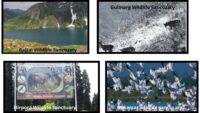
Jasrota Wildlife Sanctuary:
Jasrota wildlife sanctuary is situated on the banks of the Ujh River, around 60 km from Jammu. It spreads around 10 square kilometers. The best season for bird viewing is between March and May and mammal sighting is from September to March.
Jasrota Wildlife Sanctuary is rich in flora and bamboo plantations dominate here. The main species found are Dalbergia Sissoo, Acacia Catechu, Lannea Grandis, etc. Major shrub associates are Carisa spinarum, Dodonea Visacosa and Lantana camara. The wildlife sanctuary is the natural habitat for a wide variety of mammals like cheetal, Barking deer, wild boar, and rhesus monkey.
Lachipora Wildlife Sanctuary:
Lachipora district is located nearly 90 km from Srinagar and is popular for Lachipora Wildlife Sanctuary. The sanctuary was established in 1987 by the Department of Wildlife Protection and spreads around 80 kilometers.
Various kinds of forests and trees exist in Lachipora Wildlife Sanctuary that include Coniferous forests, Broadleaf forests, and meadows of Alpine pastures. Large numbers of herbs are found here. Bushes and shrubs of stunted growth can be observed in the isolated areas of the sanctuary.
Lachipora Wildlife Sanctuary is home to the rare species of markhor and goral. Himalayan Musk Deer is rarely found at high altitudes. Leopard, Brown bear and black bear are other creatures spotted here.
Kazinag National Park:
Located in the Baramulla district of J&K, Kazinag National Park or Qazinag National Park was established based on mounting pressure to conserve the rare markhor wild goat by Wildlife Trust of India. Kazinag has warm summers and cold winters, and the temperature ranges between -20 to +30 °C.
The reserve is covered with Coniferous forests at low altitude, fir and spruce at higher altitude. Alpine meadows occupy the highest elevations. Other shrub species include Viburnum grandiflorum and Rosa macroflora that are dominant.
There are around 20 species of rare mammals sighted here. Apart from markhor, common sightings here include Himalayan musk deer, Himalayan brown bear, black bear, leopard, Himalayan marmot, yellow-throated marten, and Kashmir flying squirrel.
Nandini Wildlife Sanctuary:
Nandini Wildlife Sanctuary is located around 28 kilometers from Jammu. The sanctuary derives from the local Nandini village and is spread across 34 square kilometers. It is primarily a bird sanctuary that is known among people for its pheasant population.
Apart from pheasants, you can sight red jungle fowl, blue rock pigeon, Indian mynah, chakor, peafowl, and many more. Wild boar, goral, leopard, grey langur, and rhesus monkey are some of the commonly sighted mammals.
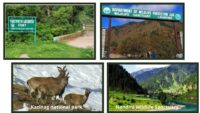
Overa Aru Wildlife Sanctuary:
Overa Aru Wildlife Sanctuary is located on the edge of two villages of Overa and Aru, hence the name. The sanctuary was established in 1981 and spreads over 511 square kilometres.
The deciduous forest occurs below 2600 meters of altitude and the coniferous forest lies between 2,600 and 3,000 metres. Junipers grow from 3500 to 3800 meters.
Overa-Aru Wildlife Sanctuary has a recorded 117 bird species, out of which, 89 species breed within the sanctuary. It is home to the critically endangered Kashmir stag. Other mammals spotted here include Kashmir musk deer, Asiatic ibex, Himalayan Serow, common leopard, Asiatic black bear, Himalayan brown bear, golden marmot and fox.
Rajparian Wildlife Sanctuary:
Also known as Daksum Wildlife Sanctuary, Rajparian Wildlife Sanctuary is located in Anantnag district. Established as Rajparian Wildlife Sanctuary in 1981, the sanctuary is spread across 20 square kilometers.
The vegetation type here includes dense coniferous and sub-alpine pastures. Rajparian Wildlife Sanctuary is home to a lot of wildlife that include the famous Himalayan black bear, hangul, musk deer and many species of wild birds.
Ramnagar Wildlife Sanctuary:
Ramnagar Wildlife Sanctuary spreads over a distance of 31 square kilometers. Located just 6 kilometers from Jammu, Ramnagar Wildlife Sanctuary is one of the closest wildlife reserves from Jammu. The place is home to a lot of rare species that include barking deer, nilgai, Rhesus monkey, wild boar, and many more. Birds include white cheeked bulbul, jungle fowl, peafowl, golden oriole, jungle crow, mynah, and many others.
Surinsar Mansar Wildlife Sanctuary:
Named after the twin lakes, Surinsar Mansar Wildlife Sanctuary that are located in the corner of the sanctuary. The park occupies an area of 98 square kilometers and is located 58 kilometers from Jammu. The park is filled with abundant flora, fauna and avifauna which attracts tourists.
The forest is covered with mixed scrub forest mostly of Pinus gerardina. Other common trees are Mallotus pjillipensis, acacia, Dalbergia sissii, bahunia variegata, ficus religosa.
There are over 15 species of birds including black patridge, jungle fowl, peafowl green pigeon and many more. Fauna includes Goral, wild boar, leopard, deer, and many more.
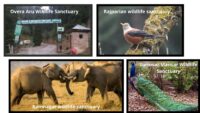
Trikuta Wildlife Sanctuary:
Trikuta Wildlife Sanctuary was Established in 1981 and covering an area of about 31.77 square kilometers, is located in Katra. The park is yet to be commercialized.
Dachigam National Park:
Dachigam National Park is located 22 kilometers from the capital of J&K. The park has been a protected area since 1910, was upgraded and declared National Park in the year 1981.
Common wildlife creatures include musk deer, leopard, Himalayan serow, Kashmir grey langur, Kashmir stag, leopard cat, Himalayan black bear, brown bear, and many more. The birds sighted here are Cinnamon sparrow, Black bulbul, Himalayan monal, Golden oriole, Minivet, Pygmy owlet, Woodpecker, Babbler, Redstart, Bearded vulture, Red-billed blue magpie, Titmouse, and many more.
Kishtwar High Altitude National Park:
Kishtwar National Park tip is located 4800 meters above sea level and spreads across 2150 square kilometers. The park provides a natural habitat to various species of mammals and and of birds. 13 vegetation types are represented here that include silver and spruce mixed with cedar and blue pine. The sub-alpine zone, from 3,000 metres to the tree line at 3,700 meters, supports mostly silver fir and birch. The national park is home to Himalayan snowcock and the brown bear.
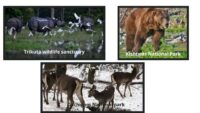
Do’s and don’ts while on safari:
Do’s:
- Groom up right for the adventure
Wear light colored dress. Make sure that the cloth you wear covers the limbs. Avoid bright colors. Multi colored dress is recommended while on safari.
2. Less luggage more comfort
This is usual and better understood by the regular travelers. Carry as less luggage as possible, which holds good for any of the expeditions. Safari expeditions can be tiresome and exhausting and carrying only what is required helps ease your tension.
3. Stay calm
Making unnecessary noises would only end up inviting trouble. Stay excited but being calm and composed throughout the exploration.
4. Do not miss your camera.
Smile! You are on a camera throughout the venture. You will come across wildlife sightings that are unexpected, breathtaking, and once in a lifetime moment. Capture them with a smile.
Carry your sunglasses, hats, and sunscreen to keep yourself safe from sun rays and sunburns. Wear strong jungle shoes along with socks. Avoid footwears which expose your feet to wild nature.
5. Always have an expert guide
The naturalists are the crew who had been in and around the jungle for years. You need a high chance of sighting wildlife; it is always recommended to have them for your venture.
Don’ts:
- No littering
Ground rule – Do not carry non biodegradable materials. The forest officials in any forests are strict of this and you may end up paying hefty funds just to ruin your holiday. Cleanliness is the key.
2. No feeding to animals
This is like digging your own grave. The behavior of wild animals are predictable to no one and hence feeding them would be risky.
3. Cell Phones switched off throughout the drive
You are on a vacation and no official/unofficial calls should spoil your vacation. Long press the power button of your device and keep it aside.
4. No loud conversations
The excitement level will be at peak especially at the time of sighting. Just enjoy the moment with less or no talks.
5. No smoking or liquors
Wildlife safari is a way to connect with nature and any toxication is not at all entertained.
6. Do not over rely on properties for safari vacations.
There are a lot of licensed properties who can arrange for safari drives when you book with them. However, they do not promise. Pro-tip. Confirm your safari drives before booking the properties.
Why To Book With WildTrails:
6 Benefits of booking your holiday with WildTrails
- Hassle free booking experience.
- Airport/ railway station, bus stand pick-up and drops shall be arranged.
- 24X7 support assistance from the experts.
- Expert Tiger Tracker for your safari.
- Sighting data (Exclusively from WildTrails) for effective planning of your wildlife venture.
- We take care of your complete holiday, from transfer, accommodation, safari, meals to make it stress-free.

————————————–
PS: Please be a responsible wildlife tourist; No littering, No sounds, No feeding, no getting down from the safari jeep (when on safari), No phone calls. Remember that we are visiting their home and when we are there, let’s follow their rules.
With 4 years of Sightings data + Extensive expert tracker network in jungles, our customers had the best wildlife experiences.
Buy Wildlife Fashion Accessories
Exclusive Online Store for wildlife products
Packages
Packages Loading...
Recent Posts





